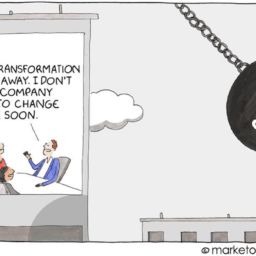
Fees and margins are down. The secular trend towards passive investments has not only eroded net inflows for active managers, but a virtual price war has also accompanied passive flows. Moreover, the sheer diversity of passive products, extending well beyond traditional core indices, has also begun to encroach on territory previously reserved for active managers. Add to this a generational transfer of wealth and other catalysts that, more than ever before, place investment decisions in the hands of the retail investor: one who is increasingly price-savvy, mobile and oriented towards self-service. This is the age of Amazon, after all. What’s an investment manager to do?
Adjusting to a New Reality
Any industry that must confront systemic change and adjust to a new economic reality will typically consider several clear business dimensions: operational efficiencies, product, and channels. Clearly, if I can produce, sell and support my product, cheaper, I can enhance my margin. Of course, this is all easier said than done, particularly for a highly regulated industry that has lots of legacy baggage and that has not always adapted to change, quickly. Regulation, too, has been both a blessing and a curse for the industry: it creates a barrier to entry for new market participants, but also imposes a significant cost on incumbents.
Sure, there are quant funds that pursue any technological advantage at their disposal in an effort to extract every scintilla of alpha that may be hidden in data, or subject to market arbitrage. But, for every Renaissance Technologies and Two Sigma there are countless other active managers who remain technically challenged and trail their respective benchmarks in good times, and in bad. Furthermore, an investment platform is only as strong as its weakest link. So, even an advanced investment engine can be dragged down by subpar operational, distribution and client servicing functions, many of which remain stale and entirely disconnected from the investment processes.
Additionally, there is the question of scale. Passive management, of course, is all about scale: it’s a volume business that derives its margin from the efficiencies, or lack thereof, built into the end-to-end platform. As fees in many index funds continue to trend towards zero, with profits dependent on securities lending activities or client up-sale opportunities, operational efficiency supported by a scalable technology infrastructure is even more important. For those who buy into the rhetoric that banks are technology companies masquerading as financial services companies, this is one such example where the business is indeed almost wholly dependent on technology.
Of course, not all investment strategies scale. The availability, access to, and liquidity of various alternative investment products certainly has limits. Further, as technology advances and the world becomes more interconnected, the information latency that has fueled many market-neutral strategies is also reduced, particularly within developed markets.
Nonetheless, active managers, including those that run fundamental strategies, must take a lead from their most successful passive brethren. They must leverage technology to achieve operational scale and efficiency; they must apply new technologies, including machine learning, to manufacture investment product and derive alpha, also at scale; they must interconnect the entire investment management lifecycle, front to back; and they must pursue new, digital distribution channels that are both cheaper and more attuned to both retail and institutional client demand.
Operational Efficiencies
Focus on your core competencies, and do not seek to differentiate that which is already commoditized, or what someone else can do better, or cheaper. Seems simple, but many companies continue to invest in proprietary platforms hosted in on-premise data centers. Cloud is here to stay and what was once an industry differentiator is now table-stakes, particularly for firms that need just-in-time access to compute, or are continually evaluating masses of data, especially in an industry that is increasingly cap-ex (and op-ex) challenged.
At one point, the security of cloud was highlighted as a reason not to move. But, consider that the investment in security by the major Cloud Service Providers (CSPs) simply dwarfs the amount that any one financial institution (FI) can spend: it is, quite simply, one of the most significant capital expenses incurred by a CSP, and subject to continual investment, since it is paramount to their core business. Note, it is still incumbent upon the cloud tenant to properly apply the security capabilities that are made available, but the capabilities are there, and are most often superior to those that are resident within any one FI.
Choose your operating platform, and partners wisely. If you agree with the premise that the industry is subject to substantial, and sustainable change, then your operating platform must reflect that. You must first try to envision how the industry, and your place within the industry is likely to evolve, before making tactical decisions to drive out cost that may ultimately prove to be incredibly expensive, unsustainable or ill-suited for the future. Too many firms make poor decisions at the outset and then fail to course-correct, whether due to the financial impact of a large impairment, fear of political backlash, or simply inertia.
Recognize that many established vendor products in the market were designed and built decades ago. Then, the operating model was inherently manual and the goal, even amongst the best systems, was to ensure sufficient data and transactional capture, and to provide a relatively efficient transfer of data, state and workflow from one team, or function, to the next.
Few, if any of these systems were designed for cloud…or to natively support the diversity of products…or to envision a scalable and automated end-to-end investment process…or to manage high volumes of accounts. Beyond the financial health of any vendor and its compliance with strong information security practices, it is equally important to consider the technology choices and implementation methodologies of the vendor, itself.
In some cases, underlying system data models have grown organically and lack a coherent schema, introducing processing latency, a higher risk of bugs and additional database tiers, often designed to help hide some of the internal complexity. Applications may be written in legacy programming languages, which makes it difficult to attract, or even find developer and support talent. Some leverage proprietary interfaces that can make integration incredibly difficult, or simply sub-optimal. Vendors may also utilize a waterfall development and delivery methodology which makes them less nimble and unable to react to the increasing pace of industry change, including in the regulatory sphere.
Most importantly, start with an aspirational business vision and chart your course, backwards. Amazon, for example, begins every new endeavor with an internal press release written to highlight the positive impact that a finished product, or service has delivered…before it’s actually been built! If the press release is compelling enough, the pitch team may secure funding; if not, R&D budget will likely be allocated, elsewhere.
Product
Commodity products should expect commodity pricing. In large part, this is reflected in the passive space where the price war is on full display. However, many active managers have not differentiated their products, or performance in ways that should justify anything more than commodity pricing, yet fees remain at a premium to passives. This is clearly not sustainable, and is noted by the general flight from active to passive products. Of course, the gaudy AUM numbers of many passive managers, historically used as a benchmark of industry success, tell only half the story, since the margins, and therefore profits, are comparatively low.…and continuing to shrink.
Managers who identify, and successfully (and sustainably) execute ways in which to reduce operating expense are certainly headed in the right direction, but one must also consider changes to product and manufacturing. In part, this requires thinking not only about the ways in which the processes and tools evolve around investment decisions, but also about the ways in which clients are likely to evolve their own engagement with managers.
The continued migration from defined benefit to defined contribution retirement plans has, more than anything, placed investment decisions in the hands of the individual retail investor. Yet, while more affluent retail investors (certainly, not all) may be supported by wealth management advisors, most are ill-equipped to manage their financial lives. The lack of financial education, complexity of product, investor malaise and fragmented investment platforms are major contributors to a sizable savings and retirement gap, even in developed nations. To simplify (or obfuscate) matters, the emergence of target date funds has drawn considerable investment contributions from 401k plans, but the application of a generic, sliding-scale asset allocation model is hardly well-suited for many investors.
The compelling notion of objective-driven investing (ODI), on the other hand, is that it seeks to design a portfolio around the client’s objectives, rather than seeking to design a client’s objectives around a portfolio. This has traditionally been the province of institutional investors and family offices, of course, since the cost to run a bespoke model requires a substantial investor commitment. What would it take, however, to provide ODI to retail investors, at scale?
With the vast amounts of data, and compute horsepower that is readily available on cloud today, one could envision the advent of an integrated digital channel through which to capture investor objectives at point-of-sale, and to seamlessly feed these objectives into systematic investment, and associated risk management engines. Such a process can also account for individual risk tolerances, as well as commitments to ESG-friendly investments, for example. Moreover, it is fit for purpose to the individual investor, yet scalable and lower cost to operate, since there is less manual handoff between functions.
Here, too, the application of select quant disciplines, especially around the use of machine learning, artificial intelligence and associated practices can be used to not only identify alpha, but to better inform managers of the kinds of objectives, and products that appeal to investors. To be most effective, alternative data sources must also continue to evolve to derive deeper insights. For example, some quant managers subscribe to anonymized credit card data in an effort to predict public retailer sales figures before earnings are released. Of course, there are many more variables that can impact a stock price, but existing credit card data feeds also lack SKU information, for example, that would enable analysts, or machines to assess supplier and component sales, as well as product trends.
Importantly, however, such a next-gen manufacturing process represents a step-change transformation of the way in which managers meet client objectives and adjust to a sustainable, lower-cost operating model. It further enables active managers to remain competitive, and offers value beyond what an investor can attain purely through passive investments.
Channels
From the moment that the individual retail investor was challenged to become a more active participant in planning for his, or her own financial future, the industry was changed…it’s just that the industry, itself, hasn’t yet fully adapted.
The advent of digital consumer retail and service channels, like Amazon, and the nearly instant gratification that such platforms evoke, has created new user expectations, more price-savvy buyers and a decided preference for self-service. The most successful of these platforms also embrace a customer-centric focus that imbues a sense of trust and loyalty – as exemplified by Amazon Prime members, for example – that many FIs would envy.
Consider, also as a backdrop, typical client acquisition costs, portfolio management costs, operational costs and client servicing costs – all exacerbated by fee and margin compression. And, while the U.S. Department of Labor’s Fiduciary Rule, first put in effect in 2017, was later vacated in 2018, it left an indelible impact on the asset management industry, as intermediaries sought to clear their shelves of under-performing, or high-priced products. Of course, this too has put further pressure on fees.
Clearly, client expectations, cost pressures and other industry challenges require an evolution in distribution.
Institutional investor mandates are typically coordinated by investment consultants, or through direct asset manager channels. Here, the mandates are generally large and patchy: this is not a volume business, and the number of clients is manageable. The retail side, of course, is a different story. Here, the volume of individual investors and the associated KYC and servicing can be quite daunting for most asset managers. This introduces several scale challenges for the typical manager that have historically been handled by wholesale intermediary, or wealth management channels.
Of course, there is precedent for asset managers and new FinTech entrants, like Betterment and WealthFront, going digital retail-direct, including through new “robo advisors”, but most managers, especially active managers, have yet to adopt such channels. The early versions of robos remain somewhat embryonic, catering to mass-market and mass-affluent investors, and principally offering basic asset allocation across passive index products, along with some enhanced capabilities, like tax-loss harvesting. Nonetheless, they offer a simple, ergonomic user interface that is objectives-driven and appeals to many retail investors. Separately, work also continues on the creation of digital identity platforms, some leveraging blockchain, that could eventually reduce, if not eliminate much of the KYC processing overhead.
Still, some traditional wealth management firms, particularly those that cater to high net worth (HNW) and above clientele, discount the impact of robos. After all, they argue, today’s robos are very simple asset allocation platforms with limited product shelves, or access to other wealth services, like private banking and estate planning. I believe this misses the point, and ignores the fact that we have only seen v.1 of the robos. Additionally, other online properties already offer supplemental capabilities, like lending and estate planning. This position further ignores the generational transfer of wealth to individuals who prefer self-service and are more comfortable with a digital experience. Additionally, by ignoring, or downplaying such channels, these wealth firms may fail to build a pipeline of younger mass-market, and mass-affluent prospects, some of whom will eventually graduate into HNW prospects.
Clayton Christensen’s well-known work, “The Innovator’s Dilemma”, paints a compelling analysis of how industry disruption occurs, and how it often begins down-market. Early on, incumbents may dismiss such a threat, in part because they are aligned with more mature client requirements and sales metrics…until it’s too late. Technology advances quickly, and can leave a trail of once-powerful companies that fail to adapt in its wake. Witness the likes of Kodak, or the impact that Amazon and other online retail consumer channels have had on brick-and-mortar shops. Why will financial services be any different?
One impediment to broader digital channel adoption remains the fragmented nature of the properties. Clients must proactively seek out these channels, each with its own user experience, as no central storefront currently exists through which to access a consolidated, multi-manager set of products and services that are presented within context of a client’s specific objectives. This simply compounds the learning curve. Ultimately, saving and investing must be presented in an easy, consistent and digestible form for the average investor. Ideally, it should be tied to more instinctual, daily activities, like purchasing or, even social networking. For these reasons, online properties, like Amazon or Facebook, may one day be positioned as the next generation of low cost financial intermediaries and financial content aggregators.
Conclusion
Systemic changes in the investment management industry are here to stay. To remain relevant, industry participants must adapt, and must embrace new digital capabilities that touch the full portfolio management lifecycle, end to end. Legacy technology platforms, including some established vendor offerings, often reflect decades-old operating processes and may not be built for future operating models. Opportunities to innovate are substantial, and the most successful firms will invest in the creation of an operating platform that not only drives efficiencies, but that is also designed to facilitate new products, manufacturing processes and client engagement methods.
In a time of deteriorating margins and difficult top-line revenue growth, the instinct to focus on cost cutting, almost exclusively, is understandable. That said, firms that pursue this path by making tactical, and often unsustainable cost cuts, particularly in technology, may be at risk of becoming casualties, as chronicled in Christensen’s “Innovator’s Dilemma”.














